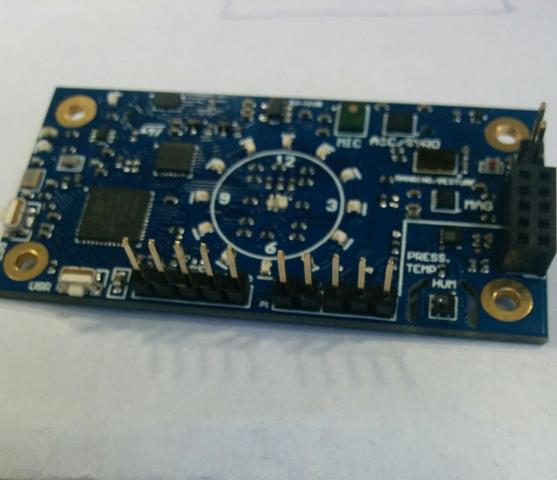96Boards Argonkey¶
Overview¶
96Boards Argonkey board is based on the ST Microelectronics STM32F412CG Cortex M4 CPU. Zephyr applications use the 96b_argonkey configuration to run on these boards.
This board acts as a sensor hub platform for all 96Boards compliant family products. It can also be used as a standalone board.
Hardware¶
96Boards Argonkey provides the following hardware components:
- STM32F412CG in UFQFPN48 package
- ARM® 32-bit Cortex®-M4 CPU with FPU
- 100 MHz max CPU frequency
- 1.8V work voltage
- 1024 KB Flash
- 256 KB SRAM
- On board sensors:
- Humidity: STMicro HTS221
- Temperature/Pressure: STMicro LPS22HB
- ALS: Intersil ISL29034
- Proximity: STMicro VL53L0X
- Acclerometer/Gyroscope: STMicro LSM6DSL
- Geomagnetic: STMicro LIS2MDL
- AMR Hall sensor: MRMS501A
- Microphone: STMicro MP34DT05
- 2 User LEDs
- 16 General purpose LEDs
- GPIO with external interrupt capability
- UART
- I2C (3)
- SPI (1)
- I2S (1)
Supported Features¶
The Zephyr 96b_argonkey board configuration supports the following hardware features:
| Interface | Controller | Driver/Component |
|---|---|---|
| NVIC | on-chip | nested vector interrupt controller |
| SYSTICK | on-chip | system clock |
| UART | on-chip | serial port |
| GPIO | on-chip | gpio |
| PINMUX | on-chip | pinmux |
| FLASH | on-chip | flash |
| SPI | on-chip | spi |
| I2C | on-chip | i2c |
The default board configuration can be found in the defconfig file:
boards/arm/96b_argonkey/96b_argonkey_defconfig
Connections and IOs¶
LED¶
- LED1 / User1 LED = PB2
- LED2 / User2 LED = PC13
Push buttons¶
- BUTTON = RST (BT1)
- BUTTON = USR (BT2)
System Clock¶
96Boards Argonkey can be driven by an internal oscillator as well as the main PLL clock. In default board configuration, the 16MHz external oscillator is used to drive the main PLL clock to generate a System Clock (SYSCLK) at 84MHz. On the bus side, AHB and APB2 clock runs at 84MHz, while APB1 runs at 42MHz.
Serial Port¶
On 96Boards Argonkey, Zephyr console output is assigned to USART1. Default settings are 115200 8N1.
I2C¶
96Boards Argonkey board has up to 3 I2Cs. The default I2C mapping is:
- I2C1_SCL : PB6
- I2C1_SDA : PB7
- I2C2_SCL : PB10
- I2C2_SDA : PB9
- I2C3_SCL : PA8
- I2C3_SCL : PB4
I2C3 goes to the P2 connector and can be used to attach external sensors. It goes to 100kbit maximum.
SPI¶
96Boards Argonkey board has 2 SPIs. SPI1 is used in slave mode as the communication bus with the AP. SPI2 is used in master mode to control the LSM6DSL sensor. The default SPI mapping is:
- SPI1_NSS : PA4
- SPI1_SCK : PA5
- SPI1_MISO : PA6
- SPI1_MOSI : PA7
- SPI2_NSS : PB12
- SPI2_SCK : PB13
- SPI2_MISO : PB14
- SPI2_MOSI : PB15
Programming and Debugging¶
Building¶
Here is an example for building the Hello World application.
# On Linux/macOS
cd $ZEPHYR_BASE/samples/hello_world
mkdir build && cd build
# On Windows
cd %ZEPHYR_BASE%\samples\hello_world
mkdir build & cd build
# Use cmake to configure a Ninja-based build system:
cmake -GNinja -DBOARD=96b_argonkey ..
# Now run ninja on the generated build system:
ninja
Flashing¶
96Boards Argonkey can be flashed by two methods, one using the ROM bootloader and another using the SWD debug port (which requires additional hardware).
Flashing using the ROM bootloader requires a special activation pattern, which can be triggered by using the BOOT0 pin. The ROM bootloader supports flashing via USB (DFU), UART, I2C and SPI, but this document describes the UART case only. You can read more about how to enable and use the ROM bootloader by checking the application note AN2606 [1] .
Using ROM bootloader:¶
Hereafter the documents describes basic steps to perform ArgonKey firmware flashing on a Linux PC using UART as communication channel.
Connect ArgonKey UART to your Linux PC using, for example, a USB-TTL serial cable. The flashing procedure has been tested using a TTL-232RG [4] cable with FTDI chip. The UART pins on ArgonKey can be found on the P3 low speed expansion connector on the back of the board.
- GND (black) to ArgonKey GND (P3.1)
- TXD (orange) to ArgonKey UART0_TXD (P3.5)
- RXD (yellow) to ArgonKey UART0_RXD (P3.7)
When the USB cable is inserted to the Linux PC the following device will be created: /dev/ttyUSBx (x is usually ‘0’).
Force STM32F412CG to enter in Bootloader mode
- Connect BOOT0 to 1V8 (link P2.1 to P3.30)
- Press and release the RST button
Use stm32flash utility to flash the ArgonKey:
$ stm32flash -w zephyr.bin -v -g 0x08000000 /dev/ttyUSB0
See References section for more info on stm32flash [2].
Using SWD debugger:¶
Select a commercial JTAG/SWD h/w tool and connect it to ArgonKey P4 connector.
The ArgonKey has been tested using the ST-LINK/V2 [3] tool. Once that the tool is connected to the PC through USB, it presents itself as a USB composite device with mass storage capability. The device can be then mounted in linux and the f/w can be actually copied there and will be automatically flashed by the ST-LINK onto the ArgonKey.
Example:
$ mount /dev/sdb /mnt
$ cp zephyr.bin /mnt
$ umount /mnt
